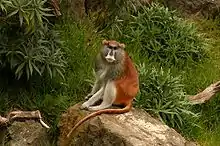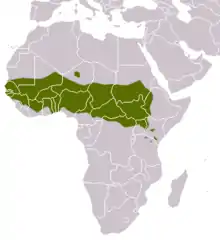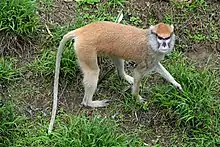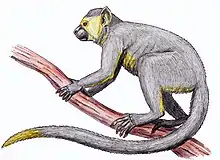Erythrocebus
Erythrocebus is a genus of Old World monkey. All three species in this genus are found in Africa, and are known as patas monkeys.[2][3] While previously considered a monotypic genus containing just E. patas, a 2017 review argued that, based on morphological evidence and heavy geographic separation between taxa, E. patas should be split back into distinct species as recognised in the 19th century.[4]
| Erythrocebus | |
|---|---|
 | |
| E. patas | |
| Scientific classification | |
| Domain: | Eukaryota |
| Kingdom: | Animalia |
| Phylum: | Chordata |
| Class: | Mammalia |
| Order: | Primates |
| Suborder: | Haplorhini |
| Infraorder: | Simiiformes |
| Family: | Cercopithecidae |
| Subfamily: | Cercopithecinae |
| Tribe: | Cercopithecini |
| Genus: | Erythrocebus Trouessart, 1897 |
| Type species | |
| Simia patas [1] Schreber, 1775 | |
| Species | |
There are three species recognized.[4][5][6]
| Common name | Scientific name and subspecies | Range | Size and ecology | IUCN status and estimated population |
|---|---|---|---|---|
| Blue Nile patas monkey
|
E. poliophaeus Reichenbach, 1862 |
Eastern Africa | Size: 49–64 cm (19–25 in) long, plus 43–73 cm (17–29 in) tail[7] Habitat: Forest, savanna, and shrubland[8] Diet: Gum and arthropods, as well as flowers, fruit, seeds, leaves, stems, roots, and small vertebrates[7] |
DD
|
| Common patas monkey
|
E. patas (Schreber, 1775) Three subspecies
|
Equitorial Africa |
Size: 50–70 cm (20–28 in) long, plus 50–70 cm (20–28 in) tail[9] Habitat: Forest, savanna, shrubland, and grassland[10] Diet: Fruit and insects, as well as leaves, roots, and bird eggs[9] |
NT
|
| Southern patas monkey | E. baumstarki Matschie, 1905 |
Eastern Africa | Size: 49–64 cm (19–25 in) long, plus 43–73 cm (17–29 in) tail[7] Habitat: Forest, savanna, shrubland, and grassland[11] Diet: Gum and arthropods, as well as flowers, fruit, seeds, leaves, stems, roots, and small vertebrates[7] |
CR
|
References
- Wilson, D. E.; Reeder, D. M., eds. (2005). Mammal Species of the World: A Taxonomic and Geographic Reference (3rd ed.). Johns Hopkins University Press. ISBN 978-0-8018-8221-0. OCLC 62265494.
- "Primate Factsheets: Patas monkey (Erythrocebus patas) Taxonomy, Morphology, & Ecology". pin.primate.wisc.edu. Retrieved 2018-03-20.
- de Jong, Y.A.; Rylands, A.B.; Butynski, T.M. (2020). "Erythrocebus patas". IUCN Red List of Threatened Species. 2020: e.T174391079A17940998. doi:10.2305/IUCN.UK.2020-2.RLTS.T174391079A17940998.en. Retrieved 25 September 2021.
- Gippoliti, Spartaco (2017). "On the Taxonomy of Erythrocebus with a Re-evaluation of Erythrocebus poliophaeus (Reichenbach, 1862) from the Blue Nile Region of Sudan and Ethiopia" (PDF). Primate Conservation. 31: 53–59. ISSN 2162-4232. Retrieved 17 January 2018.
- "Erythrocebus". Integrated Taxonomic Information System. Retrieved 12 November 2021.
- Database, Mammal Diversity (2021-11-06), Mammal Diversity Database, Zenodo, retrieved 2021-11-12
- Kingdon 2014, pp. 259, 264
- Gippoliti, S.; Rylands, A. B. (2020). "Erythrocebus poliophaeus". IUCN Red List of Threatened Species. 2020: e.T164377509A164377626. doi:10.2305/IUCN.UK.2020-2.RLTS.T164377509A164377626.en.
- Bonadio, Christopher (2000). "Erythrocebus patas". Animal Diversity Web. University of Michigan. Archived from the original on August 12, 2023. Retrieved July 24, 2023.
- De Jong, Y. A.; Rylands, A. B.; Butynski, T. M. (2022) [amended version of 2020 assessment]. "Erythrocebus patas". IUCN Red List of Threatened Species. 2022: e.T174391079A217739569. doi:10.2305/IUCN.UK.2022-1.RLTS.T174391079A217739569.en.
- de Jong, Y. A.; Butynski, T. M. (2020). "Erythrocebus baumstarki". IUCN Red List of Threatened Species. 2020: e.T92252436A92252442. doi:10.2305/IUCN.UK.2020-2.RLTS.T92252436A92252442.en.
Sources
- Kingdon, Jonathan (2014). Mammals of Africa. Vol. II: Primates. A & C Black. ISBN 978-1-4081-8991-7.
This article is issued from Wikipedia. The text is licensed under Creative Commons - Attribution - Sharealike. Additional terms may apply for the media files.





